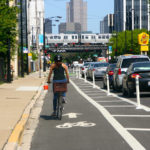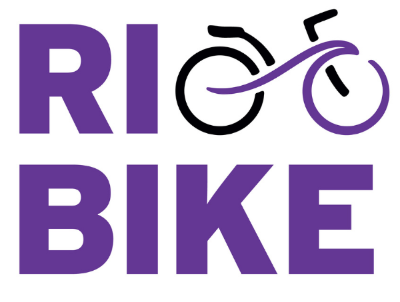
We’ve heard from public works departments and RIDOT that one of the main things holding them back from putting in more protected/separated bike lanes is uncertainty about how those bike lanes will be plowed in the winter. So this post will serve as a resource to show how other places deal with this issue.
Wait…What’s a protected bike lane again?
Since protected bike lanes are pretty new to Rhode Island, let’s review some definitions:
 Protected bike lanes: AKA “separated bike lanes”, these have something vertical separating the bike lane from where cars are driving. That could be posts or bollards, jersey barriers, or even flower planters. We don’t really have any in RI yet, though the “parking-protected bike lanes” on Fountain & Waterman Streets in Providence are close cousins, and there’s a section of the Blackstone River Bikeway near the former Lonsdale Drive-In that parallels the road. Building more of these protected bike lanes is one of the best ways to make bicycling safer and more fun for everybody.
Protected bike lanes: AKA “separated bike lanes”, these have something vertical separating the bike lane from where cars are driving. That could be posts or bollards, jersey barriers, or even flower planters. We don’t really have any in RI yet, though the “parking-protected bike lanes” on Fountain & Waterman Streets in Providence are close cousins, and there’s a section of the Blackstone River Bikeway near the former Lonsdale Drive-In that parallels the road. Building more of these protected bike lanes is one of the best ways to make bicycling safer and more fun for everybody. Regular striped bike lanes: Even these are pretty rare around Rhode Island, but if you’ve been on Broadway or Blackstone Boulevard in Providence, you’ve seen them. It’s legally a travel lane like any other, except it’s specifically for bikes. Unfortunately, the minimal separation from fast-moving and unpredictable car traffic makes it a place few people are comfortable taking their kids out to ride on. Sometimes narrow road widths make separated bike lanes difficult, and striped bike lanes are sometimes acceptable in these cases.
Regular striped bike lanes: Even these are pretty rare around Rhode Island, but if you’ve been on Broadway or Blackstone Boulevard in Providence, you’ve seen them. It’s legally a travel lane like any other, except it’s specifically for bikes. Unfortunately, the minimal separation from fast-moving and unpredictable car traffic makes it a place few people are comfortable taking their kids out to ride on. Sometimes narrow road widths make separated bike lanes difficult, and striped bike lanes are sometimes acceptable in these cases. Bike paths: Rhode Island is awesome at off-road bike paths AKA rail trails or multi-use paths. The East Bay Bike Path, the Blackstone River Bikeway, and the Washington Secondary Trail are just the three biggest of our many off-road paths. Bike paths are beautiful, but they cost about ten times as much as protected bike lanes.
Bike paths: Rhode Island is awesome at off-road bike paths AKA rail trails or multi-use paths. The East Bay Bike Path, the Blackstone River Bikeway, and the Washington Secondary Trail are just the three biggest of our many off-road paths. Bike paths are beautiful, but they cost about ten times as much as protected bike lanes.
Okay, got it; how do we plow them?
This big answer is, it depends on the details of plowing practice. Snow removal context also varies by city, so while there are a lot of great examples from around the country and the world, we have to be selective on what works here.
 Where sidewalks are already being plowed, similar equipment can be used to plow protected bike lanes. Also, for some protected bike lanes, normal pickup truck plows can be used to remove snow. In either case, de-icing and snow storage need to be planned for. Automotive travel lanes are often kept clear after initial plowing by the vehicles using them, and because of the lower weight and width of bicycles that is not as common with bike lanes. And without a specific and clearly-communicated plan about where to store snow, it’s all-too-easy for bike lanes to end up as the de facto snowpile. The City of Calgary communicates their bike lane snow policy in the infographic at right.
Where sidewalks are already being plowed, similar equipment can be used to plow protected bike lanes. Also, for some protected bike lanes, normal pickup truck plows can be used to remove snow. In either case, de-icing and snow storage need to be planned for. Automotive travel lanes are often kept clear after initial plowing by the vehicles using them, and because of the lower weight and width of bicycles that is not as common with bike lanes. And without a specific and clearly-communicated plan about where to store snow, it’s all-too-easy for bike lanes to end up as the de facto snowpile. The City of Calgary communicates their bike lane snow policy in the infographic at right.
One question we’ve been asked is whether the bollards or other vertical separation for protected bike lanes would need to be removed each year so that plowing can happen the same way it has in the past. We actually don’t see a lot of examples of this in our research; Montreal is the only place we’ve heard of this happening and they are apparently reconsidering the practice currently. It’s more common to leave the separators in place and plow the bike lane separately from the automotive travel lanes.
Ultimately, it is important for snow-clearing professionals in local and state government to work with bicycle advocates to form a plan that ensures that bike lanes are kept clear and not relegated merely to snow dumping zones. There are details of logistical procedure that need to be worked out, and the Rhode Island Bicycle Coalition is here to help work through the challenges that arise.
Resources
There are some great resources on this question with more particulars, especially:
A couple pull-outs from those pieces:
- “If you’re in a city that plows some of its sidewalks, the same equipment will probably work for bike lanes.”
- “There are multiple problems with plowing regular on-street bike lanes, and that is one key reason cities like Minneapolis are moving away from traditional on-street lanes and building more protected bike lanes, which advocates and engineers hope will be easier to maintain in the wintertime.”
- “‘The level of service we want to provide for on-street protected bike lanes is basically the same as what we try to provide for our trail system,’ said Mike Kennedy, director of Transportation Maintenance and Repair. ‘Our goal is to have them plowed and or treated within 24 hours of the end of the snowfall.’ After a regular plow makes a pass on the driving lane, the city goes back with a smaller vehicle (often a pickup truck) and plows the protected bike lane. They then often have to go back again and do some “follow up” work on the windrow (aka the ridge of snow at the plow’s periphery) around the bollards. So far, the new procedures are working pretty well.”
- Cities can expect bicyclists to use the road network year round, even in inclement conditions. It is a city’s responsibility to provide safe conditions for bicyclists year round.
This post will be kept updated as we progress toward a more robust Rhode Island specific snow clearing policy.
